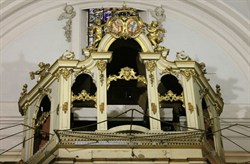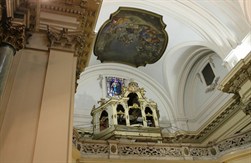“Neapolitan” Baroque in the court of the Bourbons: the organ of Saint Barbara
Queen Barbara of Braganza, the foundress of the Church of Santa Barbara in 1748, committed herself to ensuring that this temple enjoyed a good sound to accommodate an imposing organ. She commissioned the acquisition of the instrument to Carlo Broschi Farinelli, a castratoThe Castrati were singers who were subjected to castration as children, who maintained a high-pitched voice for life, thus being able to perform in female roles. singer, who, in turn commissioned the construction of the organ to the Neapolitan friar José de Monticelli, in the years 1758-1759. It was therefore made in Naples, transported by ship to Valencia and then transported on various wagons to the court of Madrid. During the long journey, the organ suffered damage which was repaired upon arrival in Madrid. The Queen herself paid for the costs of the construction and transportation of the instrument.
 The organ has a case with three façades. It is in Baroque style with golden decorations on a white background. The upper part is dominated by two angel musicians and the royal coats of arms (photo 1). The central façade, now empty for restoration and cleaning, would include three castillos de tubosThe term refers to the way to place the pipes in the windows of the cabinet, always in a geometric way and in symmetry. They are reminiscent of the towers of castles. (castles of pipes), which correspond to the organ stop on a frieze of trumpets. The lateral façades follow the same pattern, with only a “castle” on a wing of trumpets in tune with eight feet. The latticework of the lower organ is found in the lower section of the structure. The mechanical part is a mix of Baroque and Romantic organs, preserving the secretosThe box that contains the mechanisms for the distribution of the wind to the pipes. and arrangement of the original registrosA register in the organ is a set of pipes of the same timbre..
The organ has a case with three façades. It is in Baroque style with golden decorations on a white background. The upper part is dominated by two angel musicians and the royal coats of arms (photo 1). The central façade, now empty for restoration and cleaning, would include three castillos de tubosThe term refers to the way to place the pipes in the windows of the cabinet, always in a geometric way and in symmetry. They are reminiscent of the towers of castles. (castles of pipes), which correspond to the organ stop on a frieze of trumpets. The lateral façades follow the same pattern, with only a “castle” on a wing of trumpets in tune with eight feet. The latticework of the lower organ is found in the lower section of the structure. The mechanical part is a mix of Baroque and Romantic organs, preserving the secretosThe box that contains the mechanisms for the distribution of the wind to the pipes. and arrangement of the original registrosA register in the organ is a set of pipes of the same timbre..
 It is the organ that, including those described in this itinerary, represents the best combination of Italian traditions and of other places in Europe. For example, among its original registers there was the Italian flute, and its old consoleThe organist’s place, where the keyboard is – now replaced by a modern one, with pneumatic controls and a keyboard and new pedals – it had the typical characteristics of the organs of Southern Germany and Switzerland.
It is the organ that, including those described in this itinerary, represents the best combination of Italian traditions and of other places in Europe. For example, among its original registers there was the Italian flute, and its old consoleThe organist’s place, where the keyboard is – now replaced by a modern one, with pneumatic controls and a keyboard and new pedals – it had the typical characteristics of the organs of Southern Germany and Switzerland.
The magnificent organ of Santa Barbara was in a poor state of preservation. Today, as you can see in the photo (photo 2), it appears devoid of tubes and trumpets because of the restoration of the entire instrument and its case.
Technical data:
- Two manual keyboards of 54 notes, C-f'”
- Pedal of 30 notes.
- 37 registers.
- Mechanical-pneumatic transmission
